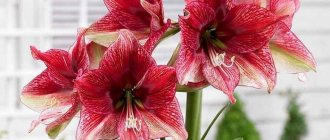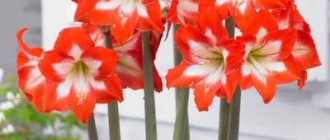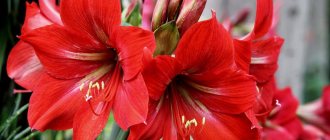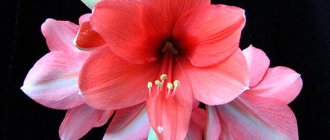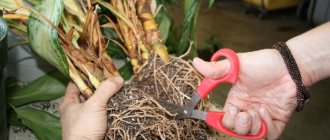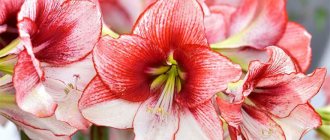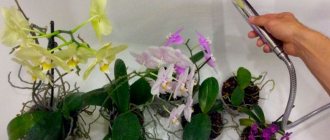Hello, dear readers! We have already written about caring for hippeastrum, today we will talk in more detail about transplanting this plant. When is it recommended to transplant hippeastrum at home and how to do it correctly so that the plants develop normally.
The hippeastrum flower, of course, will need a transplant sooner or later. But you can plant it at any time of the year, and you can even schedule its flowering time. In this case, you will see flowers 5-9 weeks after the first shoot appears. We are talking about planting bulbs purchased in flower shops. They are completely ready for this.
Planting a plant
You will need a specially shaped pot. This is due to the characteristics of the hippeastrum. The root system mainly develops in depth rather than in breadth. The plant blooms faster in conditions of limited soil volume. Therefore, you need to purchase a pot that is narrow and tall. If there is more than three to four centimeters between the wall of the pot and the surface of the bulb, you will have to wait a long time for the flowers.
Plant hippeastrum in ready-made purchased soil for bulbous plants, but it is not difficult to prepare a complete soil mixture yourself. To do this, take one part each of river sand, peat, humus and two parts of turf soil. Mix all these components thoroughly. This way you will get soil with a neutral or very weak alkaline pH reaction, which is very important for hippeastrum.
Important Tips
- Before immersing the bulb in the soil, place it in a container of warm water for two hours.
- At the bottom of the pot, be sure to make a drainage of about three centimeters.
- Fill the soil on top so that the bulb protrudes above the soil surface by a third of its length. Place it strictly in the center of the pot, add soil and moisten it a little.
- You cannot water the plant right away. The first watering is done only after dormancy, when the sprout appears. As the peduncle grows, watering needs to be increased.
- When the sprout reaches fifteen centimeters, moisten the ground once with a weak solution of potassium permanganate. A week after this, feed the hippeastrum with phosphorus fertilizers.
As a rule, flowering occurs a month after the arrow appears. As soon as the hippeastrum begins to bloom, feed the bulb regularly, otherwise it will greatly decrease in size. If you want to extend the flowering time of hippeastrum, then place the pot in a cool but well-lit place.
Transfer
If you dream of getting larger flowers and more lush leaves, you should transplant the hippeastrum directly into the flowerbed for the summer. Here the plant can gain strength until September. There is no need to wait for the first cold nights; it is better to return the plant to home conditions in advance.
Hippeastrum depletes the soil over time, despite fertilizing and proper care. Therefore, it needs to be replanted into new soil at least once every two or three years. But you need to have a good idea of how to transplant hippeastrum. This can be done only a month after flowering has completed. As a rule, the time when you can replant a flower is the end of August. You can also transplant the bulb in December, during the dormant period.
Replant with extreme caution so as not to damage the roots of the plant. After destroying the earthen clod, cut off all the dried roots and sprinkle the cut areas with crushed charcoal. After this, plant the bulb in new soil.
If you bought this flower in a store, then it is not necessary to replant it in the first year. It is quite possible to get by by replacing the top layer of soil without removing the flower from the pot. It is very important to know whether hippeastrum can be replanted during flowering. The answer is clear: under no circumstances.
Bulb damage is not a reason to be upset
It happens that due to negligence, the bulb was damaged or rot formed on it. Don't rush to throw it away. As a rule, the bulb can be saved. To do this, the area of damage or decay must be cut evenly with a sharp knife. Then immerse the bulb in a solution of fungicide, foundationazole or maxim for half an hour. An alternative option is to immerse the bulb in a weak solution of brilliant green for a day. After this, dry it at room temperature for a day.
In order to create a single multi-colored composition from several types of hippeastrum, you will need to purchase a narrow, long and deep pot. In it you can plant several bulbs in a row. The distance between the edges of the bulbs, as well as between the bulbs and the walls of the pot, should be no more than 4 centimeters.
If you strictly follow all these simple rules, then your hippeastrum after transplantation will always be healthy and very beautiful.
You can read more about hippeastrum ha care here.
Hippeastrums are famous for their luxurious flowers of various shapes and colors. And although the flowering of this indoor bulbous crop lasts up to a month and can be repeated up to three times a year, the flowers inevitably fade, and only leathery elongated leaves remain above the soil surface. Then they too may turn yellow.
What to do next when the hippeastrum has faded? How to make the bulbs gain strength and once again please the gardener with a lush bouquet at the top of the peduncle?
Vegetation of hippeastrum after flowering
The flowering of hippeastrum requires enormous strength from the plant, therefore, after the huge flowers wither, the bulb is in dire need of restoration. And this extremely important period with a single flowering usually lasts nine months. If the hippeastrum is transplanted after flowering, you will find that the bulb has noticeably lost weight and the upper scales have lost their elasticity.
Growing leaves and intensive feeding during the growing season will help the plant regain its former strength and lay the beginnings of future flower stalks:
- As the flowers fade, the arrows are cut off, leaving 10–15 cm above the bulb. Then, when the arrow is dry, it is unscrewed with a slight turn around its axis.
- Leaves appear gradually, approximately one every 3–4 weeks.
As during the flowering period, during the growing season the plants are watered abundantly and always fed. Watering is carried out carefully, on soil that has dried up from the previous time, without getting on the foliage and bulb:
- In indoor conditions, you can pour water into the pan, making sure that the moisture does not stagnate and the roots remain healthy.
- If the hippeastrum is planted in the garden after flowering, a shallow trench is made in the soil around the bulb, where watering is carried out.
Fertilizing is carried out in moist soil or combined with watering. Regular application of liquid fertilizers, especially potassium and phosphorus, will help quickly restore strength to the bulb
Caring for hippeastrum after flowering involves feeding at least 2 times a month; for seriously weakened and young plants they are done more frequently, for example, once a week.
Complex formulations for ornamental flowering or bulbous plants can be used as fertilizer.
Diseases and pests of hippeastrum and ways to combat them
Hippeastrum is happily attacked by spider mites. They are not surprised to find onion mites, scale insects, and mealybugs on the plant. They are washed off with a sponge soaked in a solution of laundry soap with the addition of alcohol. After this, the flower is treated several times with Actellik, Fitoverm or Karbofos.
Do not place pots of hippeastrum next to affected bulbous plants.
Staganosporosis is a dangerous disease that manifests itself as red spots and dots on the bulb. All affected areas are cut out and diseased parts of the plant are removed. The cut areas and the bulb are treated with Fitosporin.
Plant affected by staganosporosis
Do not plant the treated bulb immediately - it must be dried for 5-7 days. If there are no new lesions, planting is allowed. Caring for hippeastrum will consist of a little watering through a tray with the addition of a solution of Fitosporin or Fundazol. The bulb is placed high in the soil to monitor its health. Other diseases are called anthracnose and fusarium. Treatment is carried out similarly to that described above.
How to get rid of midges in indoor flowers using simple methods. In a special publication on our portal, we will talk in detail about how to get rid of pests in indoor plants. You will learn the reasons for their appearance, the types of midges and their signs and measures to prevent the appearance of midges.
Rest period for hippeastrum
Traditionally, the hibernation period for hippeastrum is arranged in the fall and early winter. It takes two to three months for the bulb to recuperate and set flower buds. The exact duration cannot be known in advance, since it depends on the intensity of the previous flowering and the care of the hippeastrum after it.
A sign of readiness for dormancy can be the wilting of leaves on a tight, large bulb. However, today there are a number of varieties and hybrids that practically do not lose leaves. In this case, you can notice that new leaf plates no longer appear:
- At the end of the growing season for hippeastrum, watering is reduced, and in September or October it is completely stopped.
- The last feeding is carried out 4 weeks before the plants are sent into hibernation.
If the hippeastrum retires in September or early October after flowering, then by the New Year holidays you can expect that the strong bulb will produce a new peduncle. For this period of time, the South American winter is simulated for the plant, providing:
- lack of lighting;
- temperature within 12–14 °C;
- low air humidity, not higher than 60%;
- extremely sparing watering to prevent the roots from dying off.
For young, non-blooming bulbs and children, a dormant period is not needed. If plants of different ages grow in the same container, it is better to plant them before hibernation.
This will prevent the plant from being damaged by replanting when it comes out of the dormant period, and will give the bulb additional nutrition. Usually, after flowering, hippeastrums go into “hibernation” and are transplanted in a pot. But you can also dig up the bulbs. In this case, they are stored on their side, without cutting off the foliage and sprinkled with sawdust. The temperature regime is the same, that is, 12–14 °C. Often with this method it is possible to achieve earlier flowering, but there is a risk of losing the bulb due to drying out.
What to do if the faded hippeastrum continues to produce leaves, already in a cool place? The bulb itself will help answer the question:
- If it is dense and has grown over the summer, the plant has completed its rest and is ready to bloom.
- But if its scales are sluggish, the grower made a mistake and sent the bulb into “hibernation” early. It is better to replant such a plant and continue to actively feed and water it.
Only healthy, dense bulbs that have fully recovered during the growing season should be sent to rest.
Such a hippeastrum will wake up on its own in a few weeks, releasing a powerful peduncle or the first leaf.
How to grow hippeastrum - video
Author: Natalya February 21, 2022 Category: Houseplants
In our latitudes, the flowering period of amaryllis begins in August-September. After flowering, amaryllis leaves naturally dry out. In order for this to happen faster, you need to gradually reduce the frequency of watering. The peduncle must be cut off before the onset of the dormant period. After a period of dormancy, leaves of amaryllis and hippeastrum begin to grow again, and the formation of peduncles and buds occurs.
Frequently Asked Questions: Hippeastrum
Home / Frequently asked questions- What is the difference between amaryllis and hippeastrum?
- How do you send your hippeastrums to rest?
- Hippeastrum has faded. What's next?
- How to feed hippeastrum?
- Is it possible to force hippeastrum to bloom twice a year?
- I bought a hippik already with an arrow (35 cm). Should I water it through the tray a little at a time?
- This is the first time I’m sending the hippeastrum to rest, and I’m already starting to tear off the penultimate half-dried leaf, when suddenly I see an arrow under it (already about 10 cm). Should I water it now, since it seems to be going through a dormant period?
- I bought hippeastrum in a box with an arrow and a bud. What to do?
- Upon transplantation, it was discovered that the bulb had more than doubled in volume. Maybe he overfed him?
- Are soft bulbs a disease? Won't mechanical damage lead to the death of the bulb?
- I examined and felt the onion - in one place it turned out to be soft! I dug it up - half the roots were rotten, the part of the onion that was sitting in the ground was soft. What to do next?
- After treating the bulb with Maxim, all the husks fell off. The bulb is bare, is that bad? There were burn marks on it.
- What does a “red burn” look like and how does it harm the bulbs? In summer, in good light, the bulb sometimes develops a scattering of red spots.
- I noticed that there were red spots on the neck of the bulb. I took it out of the ground, removed the old scales, and there - on one side the bulb had rotted down to two scales, some of the roots were red.
- Do I need to peel the bulbs down to the light scales before planting?
- Does anyone highlight hippeastrums?
- My hippeastrum has bloomed and formed a baby. Should I replant now without separating the babies or wait until the baby grows up and separate it when replanting?
- From what, excuse me, place does a flower arrow usually sprout?
- The first arrow of the hippeastrum has bloomed beautifully, there are no leaves, but the second one came out 1 cm and got stuck. How can I help her?
- Is it possible to plant several bulbs in one pot?
| General information on caring for hippeastrum. Gallery of hippeastrums from site visitors Phases of development of hippeastrums |
What is the difference between amaryllis and hippeastrum?
Answer: Hippeastrum is sometimes mistakenly called amaryllis, but the only thing they have in common with amaryllis - Amaryllis belladonna, which grows in South Africa - is that they both belong to the amaryllidaceae family (Amaryllidaceae).
If you buy amaryllis, it must be written Amaryllis belladonna and then, at the request of the manufacturer, the name of the variety can be indicated.
It is believed that amaryllis bloom leafless, and hippeastrum leafy, but this is not always the case. If this statement can be considered correct in relation to amaryllis, then hippeastrums sometimes also bloom without leaves. The most important external difference during flowering is that hippeastrum has a hollow peduncle, while amaryllis does not.
To the list of questions
How do you send your hippeastrums to rest?
Answer: I sent all the hippies to rest without watering in the refrigerator. It’s dry and warm there. A month later, the leaves turned yellow and became limp (before that, I also spent 1.5 months putting them to sleep without success). After another half a month, I pulled it out, peeled off all the dried roots, soaked it with new ones in potassium permanganate, planted it back in the pot in new soil and watered it once. I didn't water it anymore. Now, after 2 weeks, the buds are growing in a race with new ones. And among the purchased ones, 1 onion was completely dormant. Now 2 spouts of the peduncle have come out.
The article on the website briefly describes three options for growing hippeastrum indoors.
Another option for a quick retirement: the bulb is dug out of the ground and, without cutting off the leaves, is placed on its side. In this position, life processes quickly stop and the bulb “falls asleep.”
To the list of questions
Hippeastrum has faded. What's next?
Answer: Cut off the faded arrows by half. When the remaining stem dries out, simply unscrew it. After flowering, hippeastrums are not sent to rest, but are intensively fed with complex fertilizers. He sleeps for 2 months. per year, the remaining 10 blooms and grows.
To the list of questions
How to feed hippeastrum?
Answer: At the All-Russian Exhibition Center in Pav. Seeds, excellent fertilizer from the NPP VIOST company is sold. It's called "Universal". A small bag costs 4 rubles, for watering it is diluted into 10 liters. For spraying - 2 liters. Perfect for stimulating growth and for decorative foliage. Made on the basis of mixture No. 2 according to Mittlider, only it dissolves much easier (almost immediately).
There you can also buy “Phosphate” (that’s the name) from the same company (NPP VIOST). It costs the same. Stimulates flowering. It won't cause a rotten stump to bloom.
Answer: There is no need to feed the bulb during flowering, since it blooms due to accumulated fertilizers, that is, the next flower arrow begins to form from nutrients that should arrive after flowering.
Once a week after flowering until retirement, you can feed them with fertilizers containing potassium and phosphorus. I feed Kemira Lux.
Answer: Last year I fertilized some of the bulbs during flowering with local tomato fertilizer on the advice of friends from the flower club. I was amazed at the advice at first and then, after reading the composition, I realized that they were quite right. There NPK proportions are 4-6-12. As a result, the bulbs are now strong and, to put it mildly, not thinner for the next flowering season. I would never choose this fertilizer myself; I would use something traditional for flowering plants with a high phosphorus content. It would never have occurred to me that potassium is actually even better if there is more during the flowering period. Although, again, on the advice of experienced hippiasthrum growers, I now alternate feeding with this tomato thing and Pocon for flowering ones, bought in Moscow.
During flowering, I fertilize every watering. After the arrows die off, approximately once every three weeks.
Answer: When the peduncle of the forcing bulb appears, the first feeding is approximately when the arrow with the bud is about five centimeters (not counting the bud, they are very different in size) - our English liquid fertilizer, which has NPK proportions of 4-7-9. That is, phosphorus is also present, which helps flowering, as well as potassium, which guarantees the formation of buds and generally supports the bulb so that it does not lose much strength. Next, when, say, the first and second arrows fade, I also switch to liquid fertilizer NPK 4-4-12. This is the same tomato fertilizer that the club “gave” to me. I usually manage to feed it four times. Then, while the bulb stands with tops until May-June, I feed it with Pokonovsky fertilizer NPK 7-3-6 - again from the considerations that nitrogen is needed during the growing season and potassium is needed “for life.” In the summer, almost all of my adult bulbs bloom for the second time, however, the time here can no longer be accurately predicted. During the second flowering period, I manage to feed it with the first fertilizer a couple of times.
In principle, all three still contain all sorts of other elements and they are all diluted differently, one at 5 ml per half liter of water, others in a different way. If this is important, I can copy everything off the labels in detail at my leisure.
This is what happened if you mixed fertilizer with the very stuff you can always find in stores.
Period: Budding, flowering. NPK - 4-7-9 (pour into 1 liter of water).
- 8g/l Urea (urea) 4g/l N
- 18g/l Potassium sulfate 9g/l K2O
- 17.5g/l Double superphosphate 7g/l P2O5
Period: 1-2 months after flowering . NPK - 4-4-12 (pour into 1 liter of water).
- 8g/l Urea (urea) 4g/l N
- 24g/l Potassium sulfate 12g/l K2O
- 10g/l Double superphosphate 4g/l P2O5
Period: 1-2 months after flowering . NPK - 7-3-6 (pour into 1 liter of water).
- 16g/l Urea (urea) 7g/l N
- 12g/l Potassium sulfate 6g/l K2O
- 8g/l Double superphosphate 3g/l P2O5
The usual dosage is 5 ml (plastic bottle cap) for 1-2 liters of water. Every week or every other week.
Comments: from my point of view, the second and third feedings should be changed, that is, feed 4-4-12 for dormancy of the bulb or re-flowering, but that’s what the theory says.
To the list of questions
Is it possible to force hippeastrum to bloom twice a year? Mine has just finished flowering - can I put it back to sleep for a couple of months after some time?
Answer: I think that it is unnecessary to send the bulbs to rest twice; adult well-groomed plants themselves readily bloom twice a year, especially if they are kept on an open sunny balcony in the summer and even the presence of leaves does not interfere with this. Moreover, in the literature they write that hippeastrums can be cultivated without a period of rest and will bloom twice a year, although not when the owner wants, but when they themselves want it, but by a certain day, then they are given a well-deserved rest.
To the list of questions
I bought a hippik already with an arrow (35 cm). Should I water it through the tray a little at a time?
Answer: It is not advisable to water through a tray. I water mine from above with a thin stream into the edge of the pot with warm water once a week (but this is during flowering and leaf growth). Since it is already blooming, you can water it normally, not a little at a time. Such watering should be carried out at least until August.
To the list of questions
This is the first time I’m sending the hippeastrum to rest, I did everything according to the instructions, and now I’m starting to tear off the penultimate half-dried leaf, when suddenly I see an arrow under it (already about 10 cm). Should I water it now, since it seems to be going through a dormant period? And is it also possible to make it bloom on December 31st or will it bloom just in time for this date??? (Message date 07.12)
Answer: Hippeastrum usually blooms three weeks after the arrow appears... To slow down flowering, the plant is placed in a cool place and not watered. In my opinion, it is too late to slow down the 10 cm needle.
To the list of questions
I bought hippeastrum in a box with an arrow and a bud. All the roots are sticking out. The bulb itself looks completely dry. So what's now?
Answer: of course, replant it in normal soil right away! Practice shows that hippyx in any condition (even flowering) tolerates transplantation. Forcing bulbs are tenacious, just be careful with the roots.
To the list of questions
Upon replanting, it was discovered that the bulb had increased in volume more than twice during the season - this is my first bulb. Maybe he overfed him? How big do they grow? Is it necessary to regulate the size of the bulb (for example: without feeding)?
Answer: If the bulb has enlarged, then that’s great. You only need to adjust the value in the upward direction.
To the list of questions
Are soft bulbs a disease? Won't mechanical damage lead to the death of the bulb?
Answer: It depends what you mean by “soft bulbs.” The bulb usually feels a little soft to the touch as the top layer dies off, which is basically a natural process. If it is very soft, then it may already be rotten.
To the list of questions
I examined and felt the onion - in one place it turned out to be soft! I dug it up - half the roots were rotten, the part of the onion that was sitting in the ground was soft. What to do next?
Answer: Your next steps:
- remove the top layer of scales from the bulb;
- remove rotten roots;
- treat with Fundazol or Maxim;
- dry thoroughly for at least 24 hours;
- plant in light soil, digging just a little, just sprinkle the roots. Over time, add more soil;
- water very carefully until the leaves appear, being careful not to soak the bulb; put in a warm place.
To the list of questions
After treating the bulb with Maxim, all the husks fell off. The bulb is bare, is that bad? There are burn marks left on it; when scraped, they disappear. Do I need to scrape off (or cut out) all this redness from the bulb (there is not very much of it) or will it all come off on its own and you can plant it in the ground without fear?
Answer: Plant at 1/3 and then if the disease spreads, you can always spray again. If the bulb is “naked”, it is not advisable to expose it to direct sunlight until the upper scales turn brown.
To the list of questions
What does a “red burn” look like and how does it harm the bulbs? In summer, in good light, the bulb sometimes develops a scattering of red spots.
Answer: This is a protective reaction to excess light: the plant forms organic light filters that, as a rule, reflect the “red” color. After all, the maximums for chlorophyll lie in the red and blue regions. After shading the plant, these spots will disappear on their own.
To the list of questions
I noticed that there were red spots on the neck of the bulb. I took it out of the ground, removed the old scales, and there - on one side the bulb had rotted down to two scales, some of the roots were red.
Answer : Red rot is one of the most dangerous diseases of amaryllis (hippeastrum). It manifests itself in the appearance of red cracks on the bulbs and shoots of the plant. The cause of red rot is fungal spores carried by the wind. And often they are already contained in bulbs purchased at the store.
But even a severe lesion can be cured with the following set of measures:
- shake the plant out of the pot, remove the top dry scales, as well as all diseased scales; in more or less healthy ones, cut out all foci of infection to healthy tissue and sprinkle with crushed coal;
- trim off any dead roots;
- if the plant is in a state of growth, shorten the leaves;
- dry the treated onion for 5-7 days;
- pickle it before planting with a solution of foundation (you can limit yourself to surface spraying with a 1.2% solution);
- plant the bulb in a new substrate, excluding humus from it and adding crushed sphagnum. Almost the entire bulb should be above the soil. Leave only the roots and bottom in the ground. This will allow you to monitor the condition of the bulb and treat it in a timely manner in case of relapse of the disease.
- Spray the substrate thoroughly with a solution of foundationazole or Maxim. Subsequent watering should be minimal; under no circumstances should water fall on the bulb. It is better to place the pot with the onion in a cool place during the recovery period.
Remember: it is better to play it safe in the fight against infection or even abandon a diseased plant than to infect all your pets (source - Svetlana Kononova’s website “Flowers of Life”).
To the list of questions
Do I need to peel the bulbs down to the light scales before planting?
Answer : As for the husks, I only remove what clearly needs to be removed. And so, the more you peel off yourself, the more likely it is that the top living layer will begin to die off, which will lead to a shrinkage of the bulb.
Answer: If the bulb has lost a lot of weight, remove the loose-fitting couple, leaving a pair of brown ones that fit tightly. There is no need to peel the onion until it reaches the living light layer.
To the list of questions
Does anyone highlight hippeastrums?
Answer: For 10 years now, hippeastrums have been blooming at this time, when it’s dark and cold, in principle they don’t need light for this, well, maybe the flowers will be a little paler than in the summer, but in order for the buds to form, they need it in the summer the sunniest place, in principle, is also not necessary, I go to work past the house, on the window on the north side, a magnificent hippeastrum grows and blooms every spring, only because of the lack of light it has to be tied up with leaves. So highlighting the hippeastrum is absolutely unnecessary.
To the list of questions
My hippeastrum has bloomed, forming a baby, whose first leaf is also hatching. Should I replant now without separating the children or wait (how long?) until the child grows up and separate it when replanting?
Answer: IMHO, it is better to separate the babies when they appear and have 1-2 leaves, so as not to waste time on the development of both the baby itself and the maximum thickening of the parent. Let me emphasize once again that not a single gippus transplanted with leaves died when only the roots were embedded in the soil, and in this state the bulb tolerates any disinfection, degassing and decontamination, both on the roots and on the bulb itself.
But, you can separate the babies before the rest period. The most optimal scheme, if a dormant period is arranged, is to send the mother to bed after the dried leaves have died and been trimmed, and the baby to fresh soil, and left in the light with the usual (well, slightly reduced for winter, of course) watering. If you don’t want to force them to sleep, then you do approximately the same thing - when replanting in the fall, you simply separate the baby and plant it separately. Now, after flowering, I would not separate it.
To the list of questions
18. From what place, excuse me, does a flower arrow usually sprout?
Answer: it can come out of any sinus of the bulb, this does not indicate any pathology, do not worry. See photo (Hippo's arrow). From a variety of places, one strictly in the center, two on the sides and another one also hatches almost in the center. Even if there is only one peduncle at a particular moment, it will not necessarily grow from the very top of the head, from the center of the neck.
To the list of questions
And my hippeastrum arrow is stuck in the leaves. The first arrow has bloomed beautifully, there are no leaves, but the second one came out 1 cm and got stuck.
Answer: The peduncle is elongated due to lack of light. Try placing it at the bottom of a window for a few days so that it reaches towards the light. Just don't overdo it.
To the list of questions
Is it possible to plant several bulbs in one pot?
Answer: Yes. Looks great. This year I got a couple of exotic seabister varieties for the first time. Now I’ll take a closer look at them and the next time I’ll be sure to add several bulbs of the same variety or different ones, selected according to the color scheme, into a more beautiful interior, in a large bowl.
To the list of questions
Preparing amaryllis for the dormant period
The dormant period for amaryllis is the end of autumn and the beginning of winter. For hippeastrums, the dormant period begins after the plant has flowered, because hippeastrums can be driven out at any time of the year, and not just at the end of summer or early autumn. Early forcing in autumn or late is possible - then the hippeastrum blooms at the end of winter or beginning of spring. Some varieties bloom even in summer.
But whenever your amaryllis or hippeastrum blooms, it needs a period of rest. So far, only one evergreen species of hippeastrum is known - Hippeastrum Papilio, for which there is no need for a dormant period. The remaining varieties of amaryllis and hippeastrum should rest. If you planted amaryllis or hippeastrum in the ground for the summer, then you need to dig its bulb out of the ground before frost and store it in a cool, dark, dry place.
Leaves are a source of nutrients
However, the amaryllis bulb is not immediately dug up after flowering; you must first allow the leaves to do the important job of supplying the bulb with nutrients.
In the period preceding dormancy, it is necessary to prepare the bulb and give it the opportunity to recover after flowering. The leaves should dry naturally, giving all their strength to the bulb. From mid-September, the frequency of watering amaryllis (or hippeastrum) is reduced. Once the leaves have completely yellowed and died, the plant will go dormant on its own.
Wintering amaryllis and hippeastrum
The main dormant period for amaryllis is 2-3 autumn months. If the plant was planted in open ground for the summer, then after flowering the amaryllis must be dug up and replanted in a pot before frost.
Hippeastrum can be left in the ground for the winter. In general, it is enough to replant these flowers once every 3-4 years. And in order for the hippeastrum in the garden to easily withstand frost, it must be covered with a dense layer of peat or other mulch.
But if you decide to take the hippeastrum indoors for the winter, the main thing is to provide its bulb with a cool temperature within 10-18°C.
Popular questions and answers
We asked the most typical questions about hippeastrum to agronomist-breeder Svetlana Mikhailova.
How to choose a hippeastrum flower?
Hippeastrums in pots are usually sold during flowering.
It is better to take them with already opened flowers, and not with buds - this way you will be sure that the color suits you. Inspect the visible part of the bulb - there should be no stains, damage or other signs of disease. The soil in the pot should be clean, without plaque on the surface and clear evidence of waterlogging - a sour or swampy smell.
Why doesn't hippeastrum bloom?
Most often this happens because the bulb has not gone through a dormant period. Or it was too short. The minimum time for the bulb to “sleep” is 6 weeks. But often this is not enough for her. It is better to give her 2 - 3 months to rest. And another reason is the pot is too big. The distance from the wall of the pot to the bulb should be no more than 2 cm.
Are hippeastrum and amaryllis the same plant?
When hippeastrums first came to Europe, they were called amaryllis; this name firmly stuck with them, and many amateur gardeners continue to call them amaryllis. In fact, they are close relatives, but representatives of completely different genera. Hippeastrums in nature live mainly in South America, amaryllis - in southern Africa.
Sources
- Royal General Bulb Growers' Association (KAVB) https://www.kavb.nl/zoekresultaten
- Reut A.A. Results of selection of ornamental perennial crops in the South Ural Botanical Garden-Institute // Collection of scientific works of GNBS, volume 147, 2018 https://cyberleninka.ru/article/n/itogi-selektsii-dekorativnyh-mnogoletnih-kultur-v-yuzhno- uralskom-botanicheskom-sadu-institute/viewer
- Bundesinstitut für Risikobewertung // Pressemitteilung, 7.07.2007 Arkhipova I.N. Biological characteristics of representatives of the family Amaryllidaceae Jaume St.-Hil. in protected ground conditions // dissertation, 2013 https://www.dissercat.com/content/biologicheskie-osobennosti-predstavitelei-semeistva-amaryllidaceae-jaume-st-hil-v-usloviyakh
Temperature regime for amaryllis (hippeastrum)
When at rest, amaryllis and hippeastrum bulbs should be kept in a cool room. It is best if the temperature is about 15°C, but a temperature of 10°C is also considered acceptable, and the upper value is 18°C. If it is cooler, the bulb may hurt, and if it drops below 5°C, it may die.
Therefore, if you live in an area where the soil freezes below 5°C in winter, it is better to dig up the bulbs for the winter. This is especially true for amaryllis. A higher temperature than 18ºC during the dormant period may cause the bulb to germinate too quickly.
This is also not very good, since the plant did not have time to rest, and it is complete rest that guarantees the establishment of a healthy flower arrow.
During dormancy, you only need to water the bulb so that it does not dry out - once every month and a half. Moreover, water must be poured into the pan so that in conditions of cool air and excess water the bulb does not rot.
You will know that the recuperation period is over when a flower shoot appears on the amaryllis bulb. But active watering and fertilizing should begin only after this arrow extends to 10 cm. From this moment a new growth cycle of amaryllis or hippeastrum begins. Now you need to learn how to care for amaryllis at home and in the garden, depending on where it will grow.
Hippeastrum needs care after flowering, because it is during this period that the plant actively restores lost strength. The leaves continue to grow and nourish the bulb, so it is necessary to provide all the conditions for the further development of the flower. If everything is done correctly, then the grateful hippeastrum will delight you with beautiful buds not just once a year, but several times.
Why does hippeastrum not bloom, but only produce leaves?
In order for the hippeastrum to release a flower arrow, it needs a kind of stress. For what? Only in cramped conditions will the plant direct its forces to the formation of arrows and buds.
Often, gardeners create excessively comfortable conditions for hippeastrum - they plant it in a large pot, feed it with fertilizers, or water it too often and abundantly. Active leaf growth is affected by fertilizing containing nitrogen. As a result of such care, the plant actively increases its vegetative mass and refuses to bloom.
If you create the appropriate conditions for hippeastrum and strictly adhere to the recommendations regarding watering, fertilizing and planting, the plant will delight you with flowering by spring.
With proper care, hippeastrums bloom actively
Features of the growing season
Hippeastrum is a flower that can shoot out buds with almost complete absence of leaves. But when the plant fades, its green mass, on the contrary, begins to quickly and actively develop, reaching half a meter in length. During flowering, the bulb gives all its strength to the flower and loses weight - you can verify this by pulling it out of the pot after the buds have withered.
The size of the bulbs directly affects the number of future arrows - large specimens can produce several of them. At the same time, they direct all the nutrients to the development of buds. Growing and then fading leaves on the hippeastrum after flowering allow you to replenish the supply of components, so it is especially important to monitor their health.
Why does hippeastrum not bloom - only leaves grow?
The South American flower hippeastrum is not a new plant for gardeners. It has long taken pride of place in the list of the most common indoor crops. The most decorative are the large-flowered varieties - their funnel-shaped flowers sometimes exceed 25 cm in diameter. But not many people manage to admire these beautiful inflorescences. Green mass growth is often observed in indoor conditions. To understand how to make hippeastrum bloom, you should know the features of its development and the necessary growing conditions.
How to care for hippeastrum after flowering at home
Constant monitoring of the condition of the flower in the pot and comprehensive care for it guarantee future successful flowering of the hippeastrum. Particular attention should be paid to the arrow with faded buds.
What to do with the peduncle
Under no circumstances should you immediately cut off the arrow at the root; this is quite risky. You can damage the bulb, causing it to rot and die. You should do this with the arrow of a flower - cut it in several stages:
- Fading flowers should be removed immediately, thereby preventing the extraction of useful substances;
- After the flowers wither, the arrow is cut to a height of 10-15 cm above the bulb (a small stump remains);
- Then you need to wait for the arrow to dry completely;
- The dried arrow is painlessly removed - to do this, it is turned around its axis and removed from the pot.
After removing the peduncle, new green leaves will begin to form on the bulb, but their appearance will be quite slow - about 1 piece per month.
How to water
Before you start actively watering the hippeastrum, which will help it quickly restore its lost strength, you need to partially replace the soil. To do this, about 3 cm of the top layer of the old substrate is removed. Instead, new soil of the same composition is poured into the pot (usually the soil consists of turf, leaf soil, humus, sand along with peat in a ratio of 2:1:1:1).
Watering is carried out taking into account the following recommendations:
- You need to make sure that water does not get on the bulb itself and the growing leaves;
- For irrigation, settled water at room temperature is used;
- The soil should be moistened moderately, excluding overwatering (this can cause rotting of the roots and bulbs);
- Instead of top watering, you can use bottom watering, filling the tray.
How to fertilize
Caring for hippeastrum after flowering also includes fertilizing the soil. Typically, fertilizing is carried out together with watering - for this, the complex composition is combined with water, dissolving in it. You can also fertilize moistened soil in a pot.
Reasons for lack of flowering
Getting hippeastrum to bloom is not so easy. First of all, you need to pay attention to the factors that can affect the appearance of flowers. They will indicate the reason why the hippeastrum does not bloom.
Alternating vegetative and dormant phases
The development of a flower has its own characteristics - a period of active growth and flowering alternates with a period of rest. Only if the cycle is followed does the plant bloom. For this reason, they create an environment conducive to a smooth transition of the flower from one phase to another.
The dormant period lasts from September to November. Closer to the beginning of this phase, reduce the frequency of watering and stop fertilizing. The pot is moved to a cooler and shaded place. Gradually, the growth of leaves will stop and they will begin to wither and dry out.
It is important to know! The resting phase should occur as naturally as possible. You should not move the flower from place to place, or remove drying leaves.
At the end of November, the hippeastrum begins to awaken. To do this, place the pot in a warm and bright place. Watering is gradually increased.
Degree of bulb penetration
The correct planting of the hippeastrum bulb plays an important role. The depth of its placement in the ground directly affects the presence or absence of flowers.
When planting a bulb, it is buried only 2/3 of the way, and the rest should be above the soil surface. When planting, the soil is either ready-made or a mixture of turf soil, peat and sand in a 2:1:1 ratio.
Proper planting of the bulb is the key to flowering
Conditions of detention
Hippeastrum can bloom only in the most favorable conditions. To do this, you should take into account a number of recommendations that relate to keeping the flower indoors.
Lighting
Diffused but intense light is preferred. The ideal option for placing the pot would be a southwest window.
Humidity
Optimal humidity levels are 70-80%. Foliar spraying is not recommended. To increase the humidity level, it is recommended to install trays with wet pebbles or expanded clay in close proximity to the pot. The ideal option is a humidifier.
Watering
During different periods of development, the abundance and frequency of watering differs. In a state of active growth and flowering, the soil is moistened regularly as the soil dries out by 2-3 cm. After flowering, watering is reduced. During the dormant period, the soil is moistened no more than 2-3 times.
Temperature
Hippeastrum grows and develops best at temperatures of 20-22 ℃ above zero. In winter, it is reduced to 12-15 ℃.
Soil composition
For planting bulbs, use a nutritious and breathable substrate. It can be purchased at a garden center or prepared from peat, sand and turf soil at home.
Feeding
Mineral fertilizers begin to be applied when the height of the flower shoot is 12-15 cm. Re-feed twice during the flowering period with a frequency of 14-16 days. As a fertilizer, it is preferable to use mixtures in which phosphorus and potassium predominate.
Note! To understand why hippeastrum does not bloom, care at home should be carefully analyzed. If you take proper care and do everything according to the rules, the result will be accurate.
By following all the recommendations listed above, you can expect that in December the hippeastrum will not only begin to produce leaves, but will also bloom.
Pot size
The flower has a peculiarity - it grows better in close quarters. Only in a small pot does the bulb produce flower arrows. The size of the container for planting should exceed the diameter of the bulb by no more than 1-1.5 cm.
On a note! The roots of the hippeastrum grow deep, without growing in width at all. The pot is chosen to be deep and of small diameter.
The pot needs to be narrow and deep
Diseases and pests
Only a healthy plant can grow, let alone bloom. Hippeastrum affected by diseases or pests is not able to form an arrow and inflorescences. If the flower care rules are not followed, the bulb may suffer from powdery mildew and various rots.
The main cause of trouble is excessive watering. If the plant is already affected, the bulb is removed from the pot, cleaned of scales damaged by the disease and processed. Additionally, replanting is carried out with a complete replacement of the soil into a disinfected container.
Additional Information! The flower also suffers from pests. The most frequent guests are thrips, spider mites and aphids. In such a situation, first of all, the flower is isolated from other plants, and then help is provided by treating it with insecticides.
How to send hippeastrum “to rest”
From time to time, the hippeastrum needs rest. Therefore, when it has bloomed, then a dormant period is organized for the bulb according to the following scheme:
- The bulb is carefully examined and only if it is dense and healthy can the flower be sent to rest.
- After all the leaves turn yellow and dry out, watering stops.
- The hippeastrum is placed in a place where several conditions are met:
- Lack of direct sunlight, darkness;
- Temperature range within 10-18 degrees Celsius (optimally 15 degrees);
- Without a lot of moisture.
The duration of the dormant period can vary for individual varieties from 1 to 3 months. Some hippeastrum hybrids do not shed leaves and are always in the active phase, and therefore do not require “rest” for the bulb.
During the dormant period, it is recommended to water the plant once - after the earthen clod has completely dried. And then you need to periodically moisten the soil by spraying it with a spray bottle. Hippeastrum should be kept in a dark room all the time. Only after the bulb sends out a peduncle, the plant is placed in the light and normal watering is resumed.
Some gardeners practice alternating periods of flowering and dormancy, which helps achieve more frequent growth of shoots and buds at home. Such hippeastrums can delight their owner several times a year, sometimes even quarterly.
However, it is worth remembering: if the leaves of the hippeastrum do not turn yellow or fall off, then there is no need to force it to sleep.
Many gardeners who have recently acquired a hippeastrum indoor plant? They often ask if he needs a period of rest. The hippeastrum should subside. This will allow you to regulate its flowering period and improve vegetative development.
Reproduction
Hippeastrums are propagated by seed and vegetative methods. The first is considered to be quite long-lasting, energy-consuming and ineffective, since it does not guarantee the preservation of the mother cells by the flower. The second is a more common and effective option. It involves two methods: propagation by “children” or by dividing the bulb.
Seeds
Mostly, the propagation of hippeastrum by seeds is chosen by breeders, because the plant needs to be pollinated independently, artificially. Seedlings after a successful procedure will appear in a couple of months.
Only freshly harvested seeds provide 100% germination. Therefore, it is important to determine the timing in order to plant them in sandy and leafy soil in the spring. Shoots will appear in about 15-20 days. A plant grown in this way will bloom in about the fourth or fifth year.
"Kids"
Peculiarities. This is a natural, and therefore the most favorable way. Three-year-old hippeastrum bulbs, with proper care, produce three “babies” that grow on the sides of the mother bulb. We transplant the “babies” in five stages.
- Carefully separate the small onions from the main one.
- Sprinkle the separation area with charcoal or activated carbon or ash.
- We plant them in the prepared soil, deepening the bulbs to half their height.
- Until the first leaves appear (one and a half to two months), keep the soil moist. These are optimal conditions for the formation of a strong root system.
- We transplant the bulbs with young leaves into separate pots.
If for some reason the bulb dries out or, conversely, rots, try to save the plant. To do this, cut off all healthy, succulent scales, disinfect them in a fungicide solution, plant them in prepared loose soil, water and cover with polyethylene to create a greenhouse effect. The first shoots will hatch in 10-14 days. Thus, without roots it is possible to obtain new bulbs.
By dividing the bulb
Flower growers are increasingly practicing this method of breeding hippeastrum. However, this method is quite risky, since infection can get into the wound (incision site). In this case, the transplant involves the following five steps.
- Choose an adult, healthy onion.
- Cut in half, leaving equal parts of scales and roots on each slice.
- Sprinkle the fresh cut with charcoal.
- We plant the halves in a peat substrate.
- After the “babies” appear (maximum in a couple of months), we place them in separate containers.
Depending on the size of the bulb, it can be divided into a larger number of lobes (up to 16). Their width should be 1-2 cm.
Growing hippeastrum at home has its own specific characteristics, but novice florists can easily master the features of caring for and propagating this beautiful decorative flower. If you decide to grow a full-fledged flowering plant yourself from daughter bulbs, be patient. For the first two years, the young hippeastrum is not deprived of foliage and is not sent to rest: the growth of the bulb and the formation of buds in it will depend on the intensity of leaf growth. The hippeastrum will delight you with the first flowers of extraordinary beauty, towering above the succulent leaves, in three years.
The rest period of the hippeastrum - when it occurs and how it proceeds
When and how should hippeastrum be put to sleep and why does hippeastrum need a rest period:
- hippeastrum needs a period of rest to regulate flowering and normal development - any experienced gardener will say this. You need to put to rest those bulbs that bloomed in the spring. Young bulbs (under three years of age) do not need to be sent to rest. In some cases, hippeastrum blooms once in the spring, and a second time closer to October-November. In this case, the hippeastrum bulb is put to rest if it does not send out new leaves after flowering. This can be checked by spreading the middle of the crown at the base of the leaves. If no new forcing is expected there and the hippeastrum does not bloom, then the plant can be prepared for sleep;
- hippeastrum is prepared for the dormant period as follows : it is NOT WATERED AT ALL. They start doing this in mid-September. By the end of September, the plant with its lush crown is moved to a dark and cool place where there is no sun rays at all or their amount is minimal. The room temperature should not rise above 13 degrees. In such conditions, the leaves of the hippeastrum begin to dry out and, as they become dead, they are removed. It is not recommended to cut off the still green leaves and thus forcibly send the hippeastrum into a dormant period. All nutrients from the leaves must go into the bulb. By cutting off the green leaves, you deprive the bulb of a significant supply of nutrients. As a result, the plant, even if it has planted a flowering arrow, will bloom sparingly and instead of 4-5 buds it will throw out only 1 or 2 pieces;
- The dormant period of the hippeastrum begins when it begins to shed its leaves . They lose color and begin to dry out. As a result, the plant loses its entire crown. Hippeastrum without foliage should be kept in a dark and cool place until January-February. At this time, the bulb cannot be watered, otherwise it will rot;
- The dormant period of the hippeastrum ends when it begins to throw out a flower-bearing arrow . If this does not happen, the plant begins to wake up on its own. It is taken out to a warm and well-lit place and carefully watered. In this case, you don’t need a lot of liquid, again, so that the onion doesn’t rot.
Hippeastrums in the garden in summer. In such cases, they are dug up in September and transferred from the soil in pots to a warm room. However, there is no need to stimulate the further development of the plant (growth of a green crown) at home. It is better to immediately move the pot with the plant to a dark and cool place and wait until the flower begins to shed its leaves. During the same period, it is possible to separate the adult bulb from possible children that formed in the summer.
If the hippeastrum photo receives care at home, then it must be separated from the children during transplantation.
Varieties of indoor plant hippeastrum with photo: flower catalog
A large number of varieties of the genus Hippeastrum can boast of excellent diversity thanks to the easy process of crossing. Yellow, orange and even green flowers look wonderful in the house. The shape of the flower is also variable. Hippeastrum of any variety requires full care at home. The photo below shows several beautiful, unpretentious varieties. Rarely do modern plants form children, which contributes to the full preservation of the bulb. Let's get acquainted with popular varieties and hybrids, bred with love and attention.
Magnum is noticeable from afar with its deep red, cherry-tinged terry flowers.
The photo below shows a fabulously beautiful white hippeastrum.
Alfresco is a double variety with a greenish core and 3-4 rows of petals. The total diameter of one flower is 15 cm.
Ambiance pleases with a combination of red and cream shades and a large flower size
Among our favorite varieties we will name the large-flowered Andes. Its double flowers provide great aesthetic pleasure.
Gentle Andes always pleases the eye
Baby Star admires the waviness of the petals. There are 5-6 flowers on one high arrow
The Black Pearl variety is translated as black pearl. Dark cherry flowers reach 21 cm in diameter and resemble an equal-pointed star.
Black Pearl has a black-purple patina
Bogota offers 4 flowers per peduncle
There are several other popular varieties, among which pink chocolate-green Chico and light green Evergreen are especially interesting.
Chico's funny petals
Unforgettable Evergreen - evergreen
